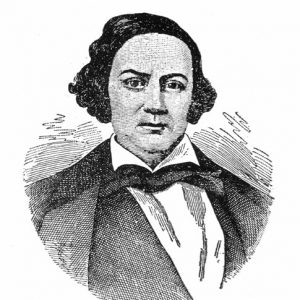calsfoundation@cals.org
Samuel Adams (1805–1850)
Samuel Adams served as acting governor of Arkansas from April 29, 1844, to November 9, 1844. As president of the state Senate, Adams became governor when Arkansas’s second state governor, Archibald Yell, resigned after being elected to Congress only six months before the end of his term. After his time as acting governor, Adams went on to serve as state treasurer until his retirement.
Samuel Adams was born in Halifax County, Virginia, on June 5, 1805, to Sylvester Adams, a Revolutionary War soldier, and Rebekah (Boyd) Adams. When he was a child, his family moved to Humphreys County, Tennessee, where he lived until 1835. Adams was self-taught as there was no formal schooling in this rural area.
At the age of nineteen, he married Rebecca May of Dickson County, Tennessee; they had six children, four of whom died during childhood. Adams’s wife died in 1840. In 1842, Adams married widow Catherine “Kittie” Fagan. Fagan had two sons of her own who lived with them in Adams’s household, one of whom, James Fagan, became a Confederate general. Adams’s son, John D. Adams, became a Civil War major, plantation owner, and steamboat magnate. At one time, he owned the Arkansas Gazette.
In 1835, Adams moved his family to Johnson County, Arkansas, where he established a plantation in the Arkansas Valley. Adams built his house in a very unique fashion, using finished lumber rather than the traditional logs of that time. Cabin Creek, a creek located some three miles from his home, was first named “Stream of Cabins” after Adams built cabins for his slaves along the creek. He worked as a buyer and homesteader of lands. He acquired considerable wealth and a number of slaves. He was also the president of a bank in Van Buren (Crawford County); it closed in the 1840s. However, Adams had an interest in national and state politics, and he began his political career in 1836 as a member of the First Arkansas General Assembly, serving as a representative from Johnson County, to which position he was reelected after two years. He went on to serve two terms in the Senate beginning on the Democratic ticket in 1840 and was elected president pro tempore of the Senate in the session of 1842.
Adams became the acting governor of Arkansas by default when Governor Archibald Yell resigned in April 1844 after being elected to the U.S. House of Representatives. (There was no position of lieutenant governor in Arkansas at this time.) During his time in office, he continued the policies of former governor Yell, specifically concerning education and the budget. He left a surplus of over $125,000 in the state treasury when he left office. Adams’s brief tenure saw a long drought, which was detrimental to the financial condition; many private business enterprises failed. There were also issues concerning Native Americans on the western frontier. Adams was ill during the majority of his time as governor. On November 9, 1844, Thomas Stevenson Drew took over the position after being elected.
In 1844, Adams was elected as state treasurer—a position for which he had been a candidate before taking over the office of governor—and moved from Johnson County to Little Rock (Pulaski County). He held this position until his retirement in 1849.
Adams died on February 27, 1850, while visiting his plantation in Saline County. He is buried in Mount Holly Cemetery in Little Rock.
For additional information:
Arkansas Biographical Dictionary. St. Clair Shores, MI: Somerset Publishers, Inc., 1998.
Donovan, Timothy P., Willard B. Gatewood Jr., and Jeannie M. Whayne, eds. The Governors of Arkansas: Essays in Political Biography. 2nd ed. Fayetteville: University of Arkansas Press, 1995.
The Goodspeed Biographical and Historical Memoirs of Central Arkansas. Chicago: Goodspeed Publishing Co., 1889.
Langford, Ella Molloy. Johnson County, Arkansas, the First Hundred Years. Clarksville, AR: Ella M. Langford, 1921.
Jaci Manning
Little Rock, Arkansas






Comments
No comments on this entry yet.